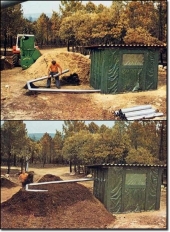posted 5 years ago
Welcome to permies Jeff!
We have a small brooder with an attached run that we use for ~130 day old meat chicks until 2-3 weeks of age. (brooder maybe 10ft X10ft max). I'm concerned that you seem to accept that there will be ammonia-filled air as a given. My current system uses layers of jute coffee sacks I get really cheap from a local organic coffee company. I add an extra layer based on age, where they've pooped the most, and I try to do so *before* I start to smell anything. We have a fan for circulation and open a sliding window after 3-4 days as we're reducing the temperature, but the window's only ~10 inches square. By 2 weeks we're opening the pop-door first during the heat of the day and gradually longer. We usually move the largest chicks to a portable shelter on grass at about 2 1/2 weeks (weather dependent), which decreases the density in the brooder to accommodate chick growth. If things work out according to plan, I don't remove any sacking until the birds leave so that I don't put mold into the air. If the weather causes a problem, I'd chase all the chicks into the run, remove some sacking, put fresh sacking on top, let any dust settle for at least 1/2 an hour, and then let the chicks back in. If the birds are reticent to have "outdoor play time" I remove their indoor waterers to encourage them! I also have a hanging basket outside which I fill with greens from the garden to entice them out for exercise, fresh air, and sunshine.
The key things is that the birds need plenty of warmth for the first few days, but then you need to be able to reduce the temperature. We vaguely follow Joel Salatin's chick temp chart which starts them at 92F for days 0-4 then reduces about a degree F each day for the next 4 days, then 4-6 degree F each day for the next 5 days or so by which time their bedding and bodies are usually generating all the heat they need. That can be accomplished by having more enclosed areas for "nap time" and "bed time" when they need more warmth - when they're running around eating and looking for interesting things to peck at, they don't need as much warmth. If you watch a mother hen managing a gaggle of chicks, that's what she does - lets them run around then tucks them under her feathers for a nap.
So hopefully what you're getting out of this is that you need zones of warmer and cooler spaces, and a way to manage how much heat from your compost is going where you want it/need it the most, and some sort of back-up system if you don't get your pile hot enough for those critical first 4-8 days.





